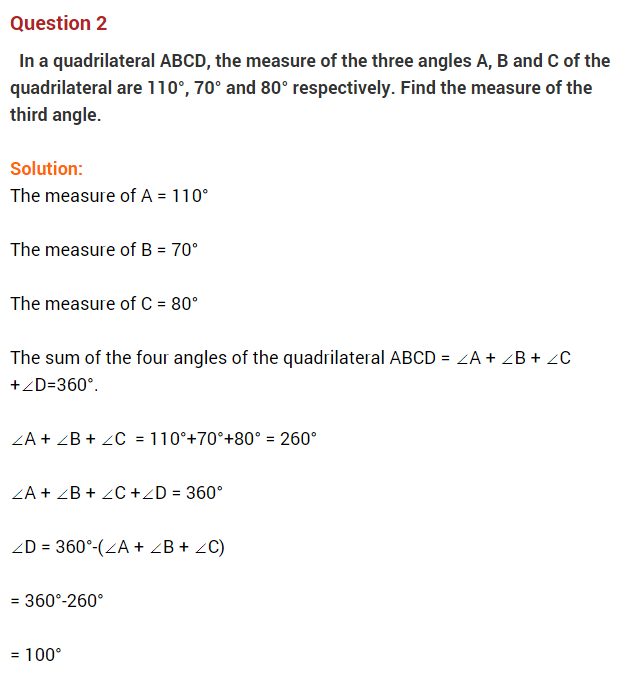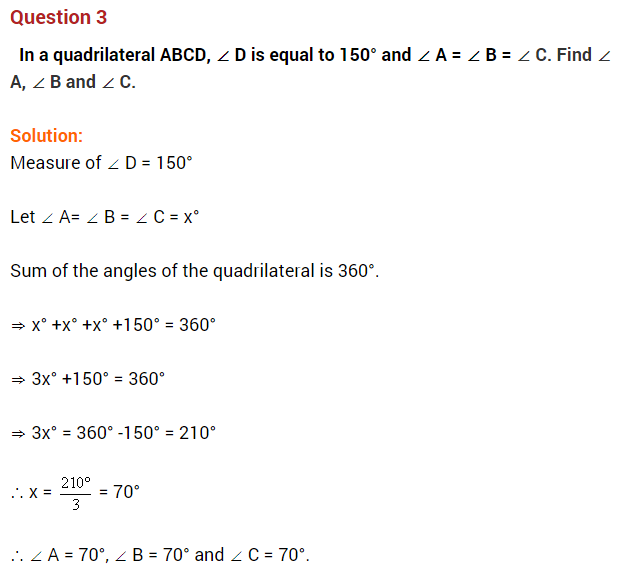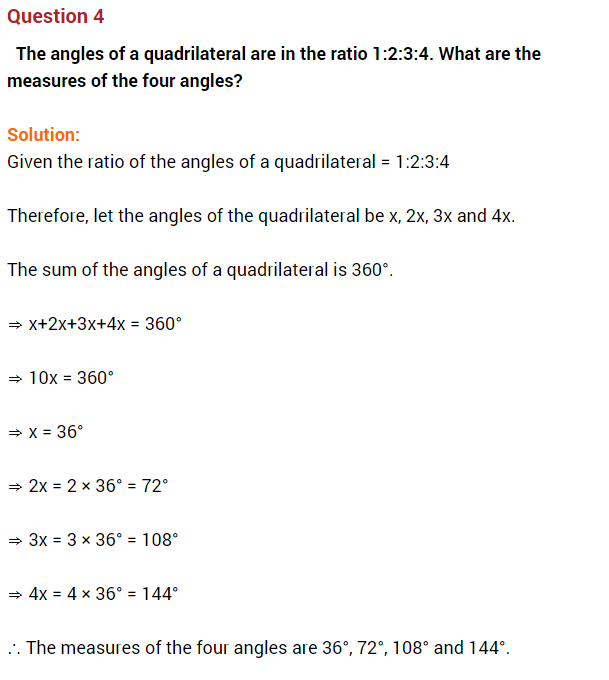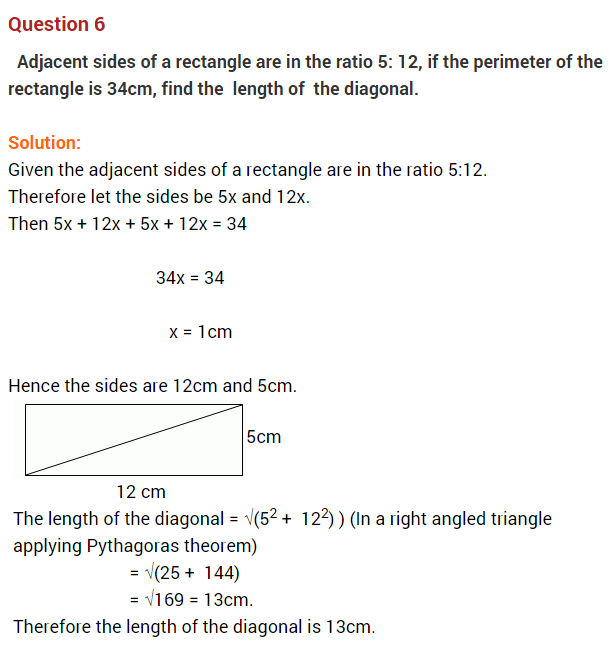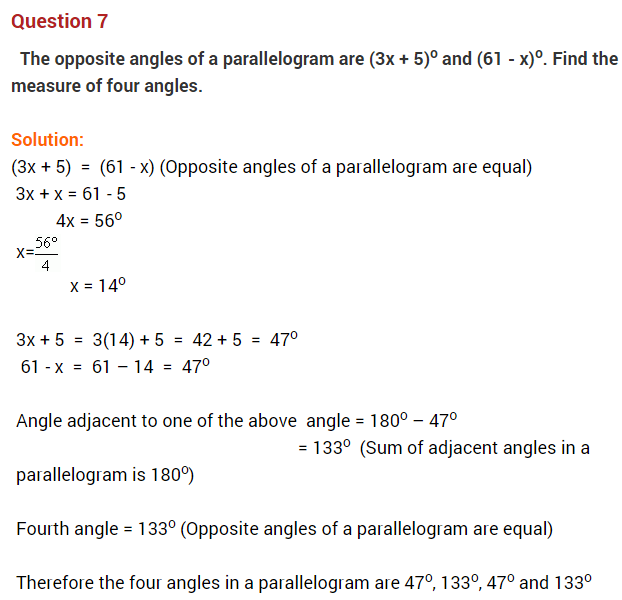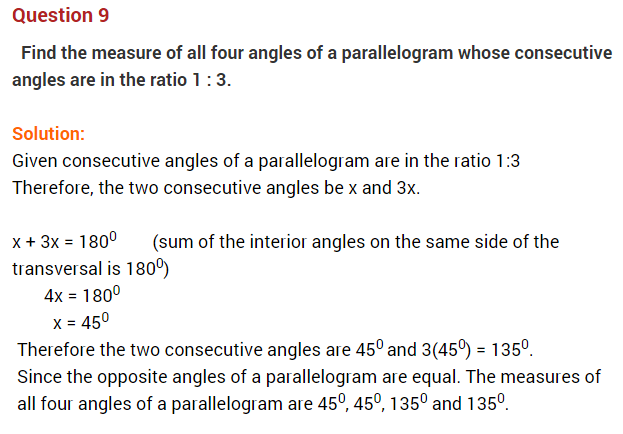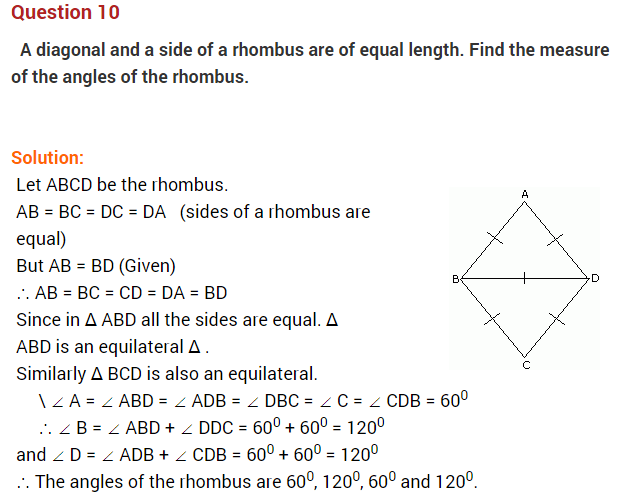Understanding Quadrilaterals Class 8 Extra Questions Maths Chapter 3
Extra Questions for Class 8 Maths Chapter 3 Understanding Quadrilaterals
Understanding Quadrilaterals Class 8 Extra Questions Very Short Answer Type
Question 1.
In the given figure, ABCD is a parallelogram. Find x.

Solution:
AB = DC [Opposite sides of a parallelogram]
3x + 5 = 5x – 1
⇒ 3x – 5x = -1 – 5
⇒ -2x = -6
⇒ x = 3
Question 2.
In the given figure find x + y + z.

Solution:
We know that the sum of all the exterior angles of a polygon = 360°
x + y + z = 360°
Question 3.
In the given figure, find x.

Solution:
∠A + ∠B + ∠C = 180° [Angle sum property]
(x + 10)° + (3x + 5)° + (2x + 15)° = 180°
⇒ x + 10 + 3x + 5 + 2x + 15 = 180
⇒ 6x + 30 = 180
⇒ 6x = 180 – 30
⇒ 6x = 150
⇒ x = 25
Question 4.
The angles of a quadrilateral are in the ratio of 2 : 3 : 5 : 8. Find the measure of each angle.
Solution:
Sum of all interior angles of a quadrilateral = 360°
Let the angles of the quadrilateral be 2x°, 3x°, 5x° and 8x°.
2x + 3x + 5x + 8x = 360°
⇒ 18x = 360°
⇒ x = 20°
Hence the angles are
2 × 20 = 40°,
3 × 20 = 60°,
5 × 20 = 100°
and 8 × 20 = 160°.
Question 5.
Find the measure of an interior angle of a regular polygon of 9 sides.
Solution:
Measure of an interior angle of a regular polygon

Question 6.
Length and breadth of a rectangular wire are 9 cm and 7 cm respectively. If the wire is bent into a square, find the length of its side.
Solution:
Perimeter of the rectangle = 2 [length + breadth]
= 2[9 + 7] = 2 × 16 = 32 cm.

Now perimeter of the square = Perimeter of rectangle = 32 cm.
Side of the square = \(\frac { 32 }{ 4 }\) = 8 cm.
Hence, the length of the side of square = 8 cm.
Question 7.
In the given figure ABCD, find the value of x.

Solution:
Sum of all the exterior angles of a polygon = 360°
x + 70° + 80° + 70° = 360°
⇒ x + 220° = 360°
⇒ x = 360° – 220° = 140°
Question 8.
In the parallelogram given alongside if m∠Q = 110°, find all the other angles.

Solution:
Given m∠Q = 110°
Then m∠S = 110° (Opposite angles are equal)
Since ∠P and ∠Q are supplementary.
Then m∠P + m∠Q = 180°
⇒ m∠P + 110° = 180°
⇒ m∠P = 180° – 110° = 70°
⇒ m∠P = m∠R = 70° (Opposite angles)
Hence m∠P = 70, m∠R = 70°
and m∠S = 110°
Question 9.
In the given figure, ABCD is a rhombus. Find the values of x, y and z.

Solution:
AB = BC (Sides of a rhombus)
x = 13 cm.
Since the diagonals of a rhombus bisect each other
z = 5 and y = 12
Hence, x = 13 cm, y = 12 cm and z = 5 cm.
Question 10.
In the given figure, ABCD is a parallelogram. Find x, y and z.

Solution:
∠A + ∠D = 180° (Adjacent angles)
⇒ 125° + ∠D = 180°
⇒ ∠D = 180° – 125°
x = 55°
∠A = ∠C [Opposite angles of a parallelogram]
⇒ 125° = y + 56°
⇒ y = 125° – 56°
⇒ y = 69°
∠z + ∠y = 180° (Adjacent angles)
⇒ ∠z + 69° = 180°
⇒ ∠z = 180° – 69° = 111°
Hence the angles x = 55°, y = 69° and z = 111°
Question 11.
Find x in the following figure. (NCERT Exemplar)

Solution:
In the given figure ∠1 + 90° = 180° (linear pair)
∠1 = 90°
Now, sum of exterior angles of a polygon is 360°, therefore,
x + 60° + 90° + 90° + 40° = 360°
⇒ x + 280° = 360°
⇒ x = 80°
Understanding Quadrilaterals Class 8 Extra Questions Short Answer Type
Question 12.
In the given parallelogram ABCD, find the value of x andy.

Solution:
∠A + ∠B = 180°
3y + 2y – 5 = 180°
⇒ 5y – 5 = 180°
⇒ 5y = 180 + 5°
⇒ 5y = 185°
⇒ y = 37°
Now ∠A = ∠C [Opposite angles of a parallelogram]
3y = 3x + 3
⇒ 3 × 37 = 3x + 3
⇒ 111 = 3x + 3
⇒ 111 – 3 = 3x
⇒ 108 = 3x
⇒ x = 36°
Hence, x = 36° and y – 37°.
Question 13.
ABCD is a rhombus with ∠ABC = 126°, find the measure of ∠ACD.

Solution:
∠ABC = ∠ADC (Opposite angles of a rhombus)
∠ADC = 126°
∠ODC = \(\frac { 1 }{ 2 }\) × ∠ADC (Diagonal of rhombus bisects the respective angles)
⇒ ∠ODC = \(\frac { 1 }{ 2 }\) × 126° = 63°
⇒ ∠DOC = 90° (Diagonals of a rhombus bisect each other at 90°)
In ΔOCD,
∠OCD + ∠ODC + ∠DOC = 180° (Angle sum property)
⇒ ∠OCD + 63° + 90° = 180°
⇒ ∠OCD + 153° = 180°
⇒ ∠OCD = 180° – 153° = 27°
Hence ∠OCD or ∠ACD = 27°
Question 14.
Find the values of x and y in the following parallelogram.

Solution:
Since, the diagonals of a parallelogram bisect each other.
OA = OC
x + 8 = 16 – x
⇒ x + x = 16 – 8
⇒ 2x = 8
x = 4
Similarly, OB = OD
5y + 4 = 2y + 13
⇒ 3y = 9
⇒ y = 3
Hence, x = 4 and y = 3
Question 15.
Write true and false against each of the given statements.
(a) Diagonals of a rhombus are equal.
(b) Diagonals of rectangles are equal.
(c) Kite is a parallelogram.
(d) Sum of the interior angles of a triangle is 180°.
(e) A trapezium is a parallelogram.
(f) Sum of all the exterior angles of a polygon is 360°.
(g) Diagonals of a rectangle are perpendicular to each other.
(h) Triangle is possible with angles 60°, 80° and 100°.
(i) In a parallelogram, the opposite sides are equal.
Solution:
(a) False
(b) True
(c) False
(d) True
(e) False
(f) True
(g) False
(h) False
(i) True
Question 16.
The sides AB and CD of a quadrilateral ABCD are extended to points P and Q respectively. Is ∠ADQ + ∠CBP = ∠A + ∠C? Give reason.
(NCERT Exemplar)
Solution:
Join AC, then
∠CBP = ∠BCA + ∠BAC and ∠ADQ = ∠ACD + ∠DAC (Exterior angles of triangles)

Therefore,
∠CBP + ∠ADQ = ∠BCA + ∠BAC + ∠ACD + ∠DAC
= (∠BCA + ∠ACD) + (∠BAC + ∠DAC)
= ∠C + ∠A
Understanding Quadrilaterals Class 8 Extra Questions Higher Order Thinking Skills (HOTS)
Question 17.
The diagonal of a rectangle is thrice its smaller side. Find the ratio of its sides.

Solution:
Let AD = x cm
diagonal BD = 3x cm
In right-angled triangle DAB,
AD
2
+ AB
2
= BD
2
(Using Pythagoras Theorem)
x
2
+ AB
2
= (3x)
2
⇒ x
2
+ AB
2
= 9x
2
⇒ AB
2
= 9x
2
– x
2
⇒ AB
2
= 8x
2
⇒ AB = √8x = 2√2x
Required ratio of AB : AD = 2√2x : x = 2√2 : 1
Question 18.
If AM and CN are perpendiculars on the diagonal BD of a parallelogram ABCD, Is ∆AMD = ∆CNB? Give reason. (NCERT Exemplar)
Solution:

In triangles AMD and CNB,
AD = BC (opposite sides of parallelogram)
∠AMB = ∠CNB = 90°
∠ADM = ∠NBC (AD || BC and BD is transversal.)
So, ∆AMD = ∆CNB (AAS)

